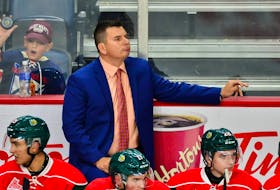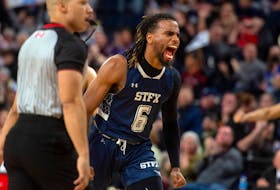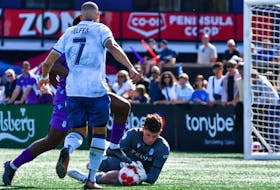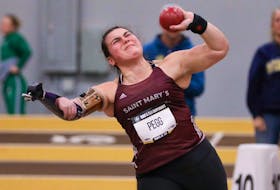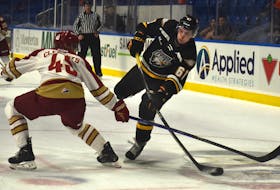From 2005-2008, Richardson was an Acadia varsity football player – AUS rookie of the year in 2005, a three-time all-conference selection and a second-team all-Canadian in 2007. That same year, he was his team’s top defensive player and MVP.
He missed the first half of the 2008 season due to an injury suffered in the CIS East-West Bowl all-star game, which may have cost him a chance to be drafted to the CFL.
That summer, he made the Edmonton Eskimos anyway, as an undrafted free agent. He started 12 games that season and ended up playing two seasons with Edmonton.
He returned to Acadia following the 2009 season to complete his degree, and at the same time, started helping the football team with strength and conditioning.
After graduation, he returned to Edmonton. He was injured in training camp, but still ended up starting nine regular season and two pre-season games.
“I got to play in the first CFL game ever played in Moncton,” said Richardson. During that 2009 game, he was named the CFL’s defensive player of the week and the Canadian player of the week.
He was released by Edmonton and followed his head coach to the Saskatchewan Roughriders.
“I played two-thirds of the year there, then was released,” he said.
Back to Acadia
Although he says it was initially a stop-gap, he says, “I had already started to focus more on strength and conditioning, and the ‘non-playing’ side of football.”
He resumed working with the football Axemen on strength and conditioning, “and bided my time to see what would happen next.”
Kevin Dickie had just taken over as athletic director, “and one of his priorities was to develop a strength and conditioning program for all of Acadia’s varsity athletes,” Richardson said.
In addition to football, Richardson was contacted by soccer and men’s basketball to help out with their teams. In April 2012, he was hired as Acadia’s first full-time strength and conditioning coach, with responsibility for all the varsity teams.
Richardson is not one to blow his own horn, but others are more than willing to do it for him. Several of the athletes profiled for this series have made a point of saying how much Richardson has helped them with their strength and conditioning.
“At the end of my first full year, 2012-2013, at the athletic awards, the Acadia Players Association presented me with their spirit award,” Richardson said.
Making better athletes
“One of the first rules of strength and conditioning training is that they don’t care how much you know until they know how much you care,” Richardson explained.
“At first, I had to put in a lot of hours to earn (the athlete’s) trust. They could see how much I cared about what I was doing, and they bought in.”
Richardson continues to rely on things he learned when he was a student.
“I learned that an average program done well will always beat a good program done poorly,” he said.
“Consistency is a big thing. Some would say it’s almost too regimented and structured, but the important thing is that it’s working.”
Another thing he learned during his time as a varsity athlete is that “hard work becomes a culture and that, in turn, drives results.” He has managed to make athletes faster, simply by having them work harder.
“It’s definitely not the easiest way to structure things, the way I do, but it’s the better way,” he said.
He works with all the varsity teams, with everything he does based on a group philosophy, working with groups of between eight to 16 athletes at a time.
“I’ve always liked other sports, and I’m enjoying working with all sports, and both genders. Everything is focused on developing better athletes,” he said.
Always active
For someone who has done so much already in his life, it may be hard to believe Richardson turned 29 recently.
“I came here first at 19. I had five years of high school in Ontario, then took a year off after graduation. I was in the CFL at 24,” said Richardson, who now resides in Bedford with his wife and commutes to Acadia daily.
Football isn’t his only passion. Growing up in Ontario, his first sport was baseball, then hockey.
“I was pretty good at both,” he said, but then football took over.
“I started playing football as a leisure activity my last year of middle school. We played touch, and even tackle. I started organized football in Grade 9. I dropped hockey, although I did play baseball my last year of high school.”
His hometown, Mimico, is known as the home of NHL players Brendan Shanahan and Dave Bolland and baseball player Joey Votto, a classmate of Richardson’s.
Looking ahead
Richardson has a degree in kinesiology from Acadia, and hopes to start on a masters degree next fall.
That degree would need to be taken though Dal, but Richardson has no plans to leave Acadia to take a masters unless it was part of another opportunity.
When he started, Richardson was one of only a handful of university strength and conditioning coaches in the country. Now, “it’s starting to become more status quo across the country.”
He is glad to be able to give back to his alma mater in this way.
“Acadia, for its size, is doing pretty well. This kind of thing is usually reserved for bigger schools. It’s a real benefit for an athlete to have access to something like this,” he added.
From 2005-2008, Richardson was an Acadia varsity football player – AUS rookie of the year in 2005, a three-time all-conference selection and a second-team all-Canadian in 2007. That same year, he was his team’s top defensive player and MVP.
He missed the first half of the 2008 season due to an injury suffered in the CIS East-West Bowl all-star game, which may have cost him a chance to be drafted to the CFL.
That summer, he made the Edmonton Eskimos anyway, as an undrafted free agent. He started 12 games that season and ended up playing two seasons with Edmonton.
He returned to Acadia following the 2009 season to complete his degree, and at the same time, started helping the football team with strength and conditioning.
After graduation, he returned to Edmonton. He was injured in training camp, but still ended up starting nine regular season and two pre-season games.
“I got to play in the first CFL game ever played in Moncton,” said Richardson. During that 2009 game, he was named the CFL’s defensive player of the week and the Canadian player of the week.
He was released by Edmonton and followed his head coach to the Saskatchewan Roughriders.
“I played two-thirds of the year there, then was released,” he said.
Back to Acadia
Although he says it was initially a stop-gap, he says, “I had already started to focus more on strength and conditioning, and the ‘non-playing’ side of football.”
He resumed working with the football Axemen on strength and conditioning, “and bided my time to see what would happen next.”
Kevin Dickie had just taken over as athletic director, “and one of his priorities was to develop a strength and conditioning program for all of Acadia’s varsity athletes,” Richardson said.
In addition to football, Richardson was contacted by soccer and men’s basketball to help out with their teams. In April 2012, he was hired as Acadia’s first full-time strength and conditioning coach, with responsibility for all the varsity teams.
Richardson is not one to blow his own horn, but others are more than willing to do it for him. Several of the athletes profiled for this series have made a point of saying how much Richardson has helped them with their strength and conditioning.
“At the end of my first full year, 2012-2013, at the athletic awards, the Acadia Players Association presented me with their spirit award,” Richardson said.
Making better athletes
“One of the first rules of strength and conditioning training is that they don’t care how much you know until they know how much you care,” Richardson explained.
“At first, I had to put in a lot of hours to earn (the athlete’s) trust. They could see how much I cared about what I was doing, and they bought in.”
Richardson continues to rely on things he learned when he was a student.
“I learned that an average program done well will always beat a good program done poorly,” he said.
“Consistency is a big thing. Some would say it’s almost too regimented and structured, but the important thing is that it’s working.”
Another thing he learned during his time as a varsity athlete is that “hard work becomes a culture and that, in turn, drives results.” He has managed to make athletes faster, simply by having them work harder.
“It’s definitely not the easiest way to structure things, the way I do, but it’s the better way,” he said.
He works with all the varsity teams, with everything he does based on a group philosophy, working with groups of between eight to 16 athletes at a time.
“I’ve always liked other sports, and I’m enjoying working with all sports, and both genders. Everything is focused on developing better athletes,” he said.
Always active
For someone who has done so much already in his life, it may be hard to believe Richardson turned 29 recently.
“I came here first at 19. I had five years of high school in Ontario, then took a year off after graduation. I was in the CFL at 24,” said Richardson, who now resides in Bedford with his wife and commutes to Acadia daily.
Football isn’t his only passion. Growing up in Ontario, his first sport was baseball, then hockey.
“I was pretty good at both,” he said, but then football took over.
“I started playing football as a leisure activity my last year of middle school. We played touch, and even tackle. I started organized football in Grade 9. I dropped hockey, although I did play baseball my last year of high school.”
His hometown, Mimico, is known as the home of NHL players Brendan Shanahan and Dave Bolland and baseball player Joey Votto, a classmate of Richardson’s.
Looking ahead
Richardson has a degree in kinesiology from Acadia, and hopes to start on a masters degree next fall.
That degree would need to be taken though Dal, but Richardson has no plans to leave Acadia to take a masters unless it was part of another opportunity.
When he started, Richardson was one of only a handful of university strength and conditioning coaches in the country. Now, “it’s starting to become more status quo across the country.”
He is glad to be able to give back to his alma mater in this way.
“Acadia, for its size, is doing pretty well. This kind of thing is usually reserved for bigger schools. It’s a real benefit for an athlete to have access to something like this,” he added.


